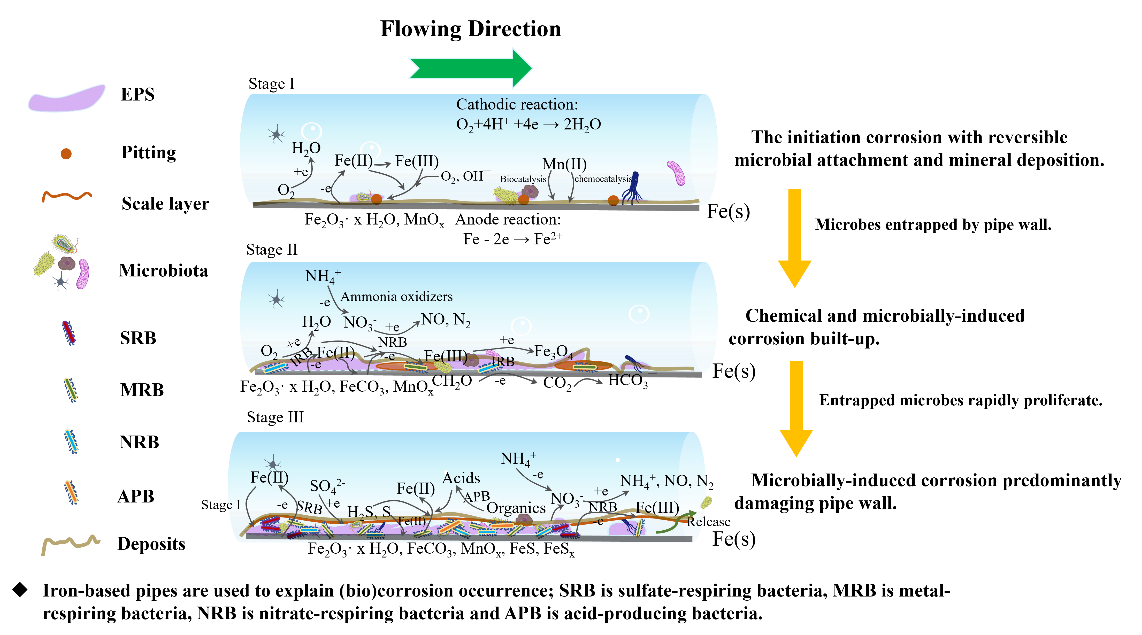课题组宋欣同学于《science of the Total Environment》期刊上发表论文,题为《Behaviors and mechanisms of microbial-induced corrosion in metal-based water supply pipelines: A review》。
微生物引起的腐蚀(MIC)是不可阻挡的并广泛蔓延到整个饮用水分配系统(DWDSs),这是导致管道泄漏和水质恶化的主要原因之一。维护饮用水安全可减少供水管道系统维护的资本投入,因此,MIC于DWDSs的影响仍然是一个研究热点。虽然已有大多数研究分析了环境因素变化对MIC腐蚀的影响,但对DWDSs中MIC发生方式过程尚未进行充分的讨论。这篇综述旨在通过提出微生物捕获沉积物的形成可能为DWDSs的MIC来源来填补这一空白。微生物早期附着在粗糙的管道表面,随后是化学和微生物诱导的矿床,从而对消毒剂产生抗性,这被认为是MIC发生的第一步。MIC然后在新建的、可行的和可接近的微环境中被激活,同时产生细胞外聚合物。随着管道使用时间的延长,低营养微生物的缓慢生长,金属管道材料逐渐随着电子向微生物的释放而同步溶解,导致管壁损伤。而不同的腐蚀性微生物使用管材作为反应基质,会直接或间接地引起不同类型的腐蚀。相应地,鳞片层的形成可能反映了微生物物种的分布和可能的生物成因产物。因此,假设多孔和松散层是一个理想的微生物生存环境,能够提供多样和充足的生态位。代谢活动过程和代谢物存在,如乙酸、草酸、柠檬酸和戊二酸,可能导致多孔鳞片层的形成。因此,管道尺度内的微生物相互作用增强了微生物群落的稳定性,加速了MIC。最后,给出了MIC过程的示意图模型,以解释MIC从开始到完成。
Abstract: Microbially-induced corrosion (MIC) is unstoppable and extensively spread throughout drinking water distribution systems (DWDSs) as the cause of pipe leakage and deteriorating water quality. For maintaining drinking water safety and reducing capital inputs in pipe usage, the possible consequences from MIC in DWDSs is still a research hotspot. Although most studies have investigated the effects of changing environmental factors on MIC corrosion, the occurrence of MIC in DWDSs has not been discussed sufficiently. This review aims to fill this gap by proposing that the formation of deposits with microbial capture may be a source of MIC in newly constructed DWDSs. The microbes early attaching to the rough pipe surface, followed by chemically and microbially-induced mineral deposits which confers resistance to disinfectants is ascribed as the first step of MIC occurrence. MIC is then activated in the newly-built, viable, and accessible microenvironment while producing extracellular polymers. With longer pipe service, oligotrophic microbes slowly grow, and metal pipe materials gradually dissolve synchronously with electron release to microbes, resulting in pipe-wall damage. Different corrosive microorganisms using pipe material as a reaction substrate would directly or indirectly cause different types of corrosion. Correspondingly, the formation of scale layers may reflect the distribution of microbial species and possibly biogenic products. It is therefore assumed that the porous and loose layer is an ideal microbial-survival environment, capable of providing diverse and sufficient ecological niches. The usage and chelation of metabolic activities and metabolites, such as acetic, oxalic, citric and glutaric acids, may lead to the formation of a porous scale layer. Therefore, the microbial interactions within the pipe scale reinforce the stability of microbial communities and accelerate MIC. Finally, a schematic model of the MIC process is presented to interpret MIC from its onset to completion.
Keywords: Microbially-induced corrosion; Occurrence; Porous scale; Interplays; Process

【文章链接】Behaviors and mechanisms of microbially-induced corrosion in metal-based water supply pipelines: A review - ScienceDirect